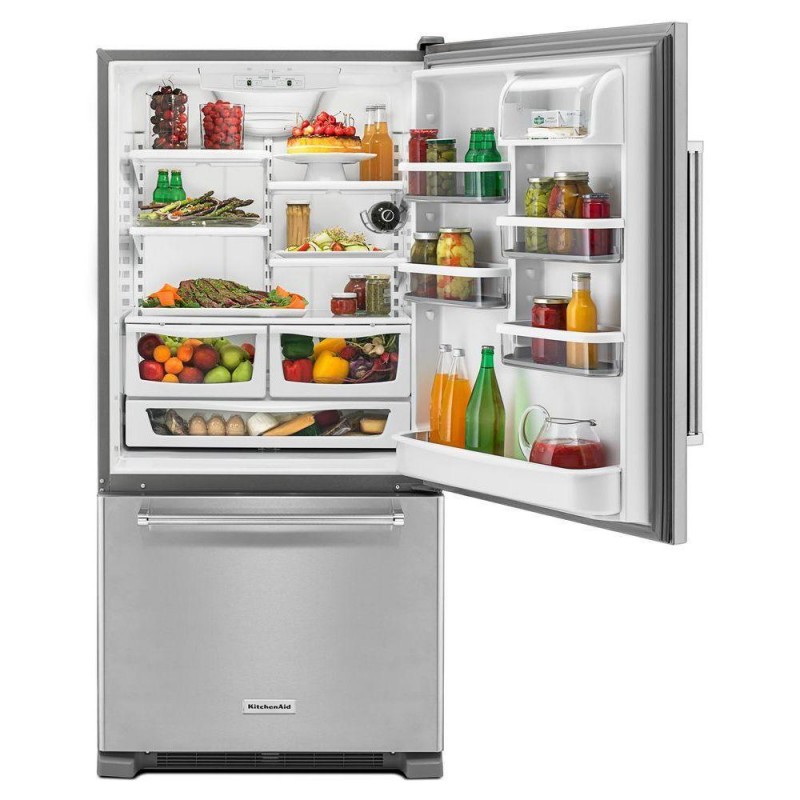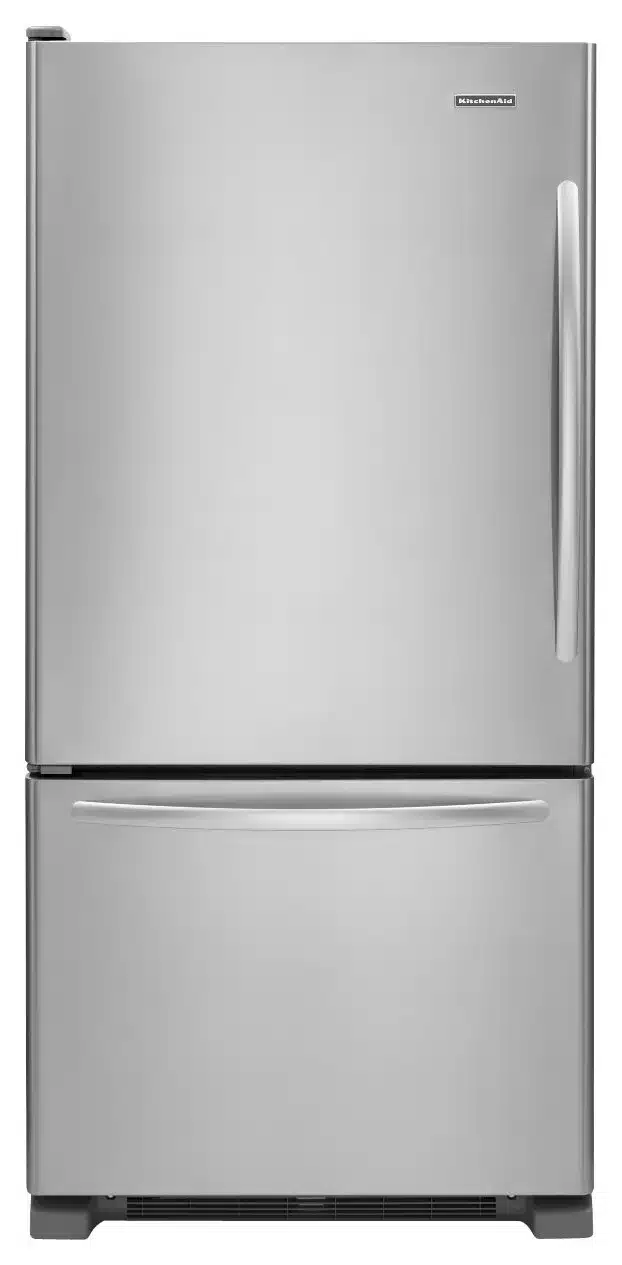If you own a Kitchenaid freezer, you know how convenient it is to have a reliable appliance that keeps your food frozen and fresh. But what if your freezer suddenly stops working as it should? What if it won’t stay at zero degrees, the ideal temperature for long-term food storage?
In this post, we’ll help you troubleshoot some common reasons why your Kitchenaid freezer won’t stay at zero degrees and how to fix them. Whether it’s a problem with the door seal, the drain, the content, or the thermostat, we’ll guide you through the steps to get your freezer back to optimal performance.
The most common reasons why your Kitchenaid freezer won’t stay at zero degrees are:
- The door seal is damaged or not functioning properly, allowing warm air to enter the freezer and cause frost buildup.
- The drain is clogged or frozen, preventing water from draining out of the freezer and creating ice accumulation.
- The content of the freezer is too high or too low, affecting the airflow and temperature distribution inside the freezer.
- The thermostat is faulty or set incorrectly, causing the freezer to run too cold or too warm.
How to Check and Fix the Door Seal
The door seal is a rubber gasket that forms an airtight seal around the freezer door. It prevents warm air from entering the freezer and cold air from escaping. If the door seal is damaged, worn out, or not aligned properly, it can cause frost buildup inside the freezer and make it harder for the freezer to maintain a consistent temperature.
To check and fix the door seal, follow these steps:
- Inspect the door seal for any cracks, tears, or gaps. If you find any damage, you’ll need to replace the door seal with a new one. You can order a replacement door seal from Kitchenaid or an authorized dealer.
- Clean the door seal with a damp cloth and mild soap. Remove any dirt, debris, or food particles that may interfere with the seal. Dry the door seal thoroughly with a soft cloth.
- Check the alignment of the door seal. Make sure it fits snugly around the entire perimeter of the door. If the door seal is loose or sagging, you can adjust it by gently pulling it away from the door and reinserting it into the groove. You can also use a hair dryer on low heat to soften the door seal and reshape it.
- Test the effectiveness of the door seal by closing the door and inserting a dollar bill between the seal and the freezer. Pull the bill out slowly. If there is little or no resistance, the seal is not tight enough. Repeat this test along different sections of the door seal and adjust as needed.

How to Check and Fix the Drain
The drain is a small hole at the bottom of the freezer that allows water from defrosting to drain out of the freezer and into a pan underneath. If the drain is clogged or frozen, water can back up into the freezer and form ice on the floor or walls of the freezer. This can affect the temperature and airflow inside the freezer and make it harder for it to stay at zero degrees.
To check and fix the drain, follow these steps:
- Locate the drain hole at the bottom of the freezer. You may need to remove some items from the freezer or use a flashlight to see it clearly.
- Clear any debris or ice from around the drain hole. You can use a small brush, a pipe cleaner, or a turkey baster to remove any obstructions. Be careful not to damage or enlarge the drain hole.
- Pour some hot water down the drain hole to melt any ice inside. You can also use a hair dryer on low heat to thaw out any frozen areas. Be careful not to overheat or damage any components of the freezer.
- Check if water flows freely through the drain hole and into the pan underneath. If not, you may need to remove and clean or replace the drain hose that connects to the drain hole.
How to Check and Fix
the Content
The content of your freezer refers to how much food you store in it and how you arrange it. The content can affect how well your freezer maintains a consistent temperature and how efficiently it uses energy. If your freezer is too full or too empty, it can cause temperature fluctuations and make it harder for your freezer to stay at zero degrees.
To check and fix the content of your freezer, follow these steps:
- Check the recommended capacity of your freezer model. You can find this information in your owner’s manual or on the manufacturer’s website. Generally, the ideal capacity for a freezer is between 70% and 85% full.
- Avoid overloading or underloading your freezer. If your freezer is too full, it can block the airflow and prevent even cooling. If your freezer is too empty, it can cause the freezer to work harder and waste energy. Aim for a balanced load that leaves some space between the items for air circulation.
- Organize your freezer items by category and size. Use bins, baskets, or dividers to separate different types of food and make them easier to find. Label your items with dates and names to avoid confusion and spoilage. Store larger and heavier items at the bottom and smaller and lighter items at the top of the freezer.
- Rotate your freezer items regularly. Use the FIFO (first in, first out) method to consume older items before newer ones. This will help you reduce food waste and prevent freezer burn.

How to Check and Fix the Thermostat
The thermostat is a device that controls the temperature of your freezer by turning the compressor on and off. If the thermostat is faulty or set incorrectly, it can cause your freezer to run too cold or too warm and make it harder for it to stay at zero degrees.
To check and fix the thermostat, follow these steps:
- Locate the thermostat dial or control panel inside your freezer. You may need to refer to your owner’s manual or the manufacturer’s website to find it.
- Check the current temperature setting of your freezer. The ideal temperature for a freezer is zero degrees Fahrenheit or -18 degrees Celsius. You can use a thermometer to measure the actual temperature inside your freezer and compare it with the setting.
- Adjust the temperature setting of your freezer if needed. Turn the dial or press the buttons to increase or decrease the temperature by one degree at a time. Wait for 24 hours for the temperature to stabilize before making any further adjustments.
- Test the accuracy of your thermostat if you suspect it is faulty. You can do this by placing a glass of water with a thermometer in it inside your freezer and checking the temperature after 24 hours. If the temperature is significantly different from the setting, you may need to replace the thermostat with a new one.

FAQs
Q: How often should I defrost my Kitchenaid freezer?
A: It depends on the type and model of your freezer. Some freezers have a self-defrosting feature that automatically melts any frost buildup every 8 to 12 hours. Other freezers require manual defrosting every 6 to 12 months or whenever the frost layer exceeds 1/4 inch thick. You can check your owner’s manual or the manufacturer’s website for specific instructions on how to defrost your freezer.
Q: How can I prevent frost buildup in my Kitchenaid freezer?
A: Frost buildup is caused by warm, moist air entering the freezer and condensing on the cold surfaces. To prevent frost buildup, you can do the following:
- Check and fix the door seal as described above.
- Avoid opening and closing the door too frequently or for too long.
- Let hot food cool down before placing it in the freezer.
- Use airtight containers, bags, or wraps to store your food in the freezer.
- Keep the humidity level in your home low by using a dehumidifier or an air conditioner.
Q: How can I save energy with my Kitchenaid freezer?
A: You can save energy with your Kitchenaid freezer by doing the following:
- Check and fix the content of your freezer as described above.
- Avoid setting the temperature too low or too high. The ideal temperature for a freezer is zero degrees Fahrenheit or -18 degrees Celsius.
- Clean the condenser coils every 2-3 months or as needed. The condenser coils are located at the back or bottom of the freezer and help dissipate heat from the compressor. If they are dirty or dusty, they can reduce the efficiency and performance of the freezer.
- Keep the freezer away from heat sources such as ovens, stoves, dishwashers, or direct sunlight. Heat sources can make the freezer work harder and use more energy.
We hope this post has helped you troubleshoot why your Kitchenaid freezer won’t stay at zero degrees and how to fix it. If you have any questions or need further assistance, please contact Kitchenaid customer service or a qualified technician.




